
Ancient populations (far apart in distance and time) are linked one to another by a mistery, upon which archaeologists, astronomers, mathematicians, artists, psychologists, historians etc. are still working: the Golden Section.
The Golden Section, also called Golden Ratio,  is usually defined as it follows: “two quantities are in the golden ratio if the ratio between the sum of those quantities and the larger one is the same as the ratio between the larger one and the smaller.” (Wikipedia).
is usually defined as it follows: “two quantities are in the golden ratio if the ratio between the sum of those quantities and the larger one is the same as the ratio between the larger one and the smaller.” (Wikipedia).
It means that AM:MB=MB:AB. Its value is about 1,618.
The Golden Ratio module has been used by the Ancients Egyptians in the Giza pyramids (ratio between the height and the base); in the Stele of Get in Abydos, Egypt (the ancient city were framed in a square built in the shortest side of the Stele, which were in Golden Ratio with the whole walls).

In the 5th century b.C., Fidia built the Parthenon, a temple of the Greek goddess Athena, on the Athenian Acropolis with the orthogonal projection of the rectangular front size included in the ratio between width and height F:1 (same as the Golden Ratio).
The Golden section has been used as proof sheet in:
- fresco paintings (Etruscan necropolis of the Baron, Tarquinia)
- architectural works (the Notre-Dame cathedral, Paris; the ONU building, New York)
- Renaissance canvas paintings (the Mona Lisa, the Last Supper and the Vitruvian Man, Leonardo da Vinci; the Flagellation of Christ, Piero della Francesca; the Birth of Venus, Botticelli and so on).

IN SUMMARY: The Golden Section has been and is used in art as “guideline” and/or cryptic message. It follows mathematical constant relative to a never-ending spiral: the Logarithmic Spiral. It also has something to do with armony, nature, esthetic standards, religion and astronomy.

 Italiano
Italiano